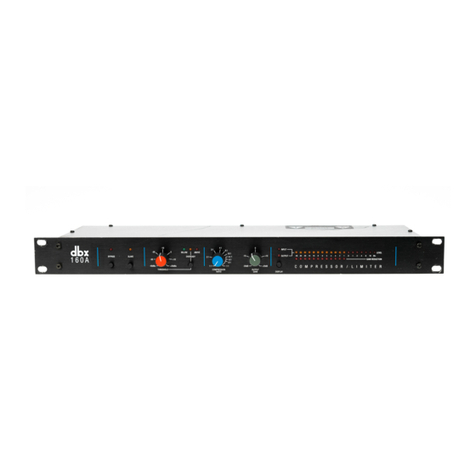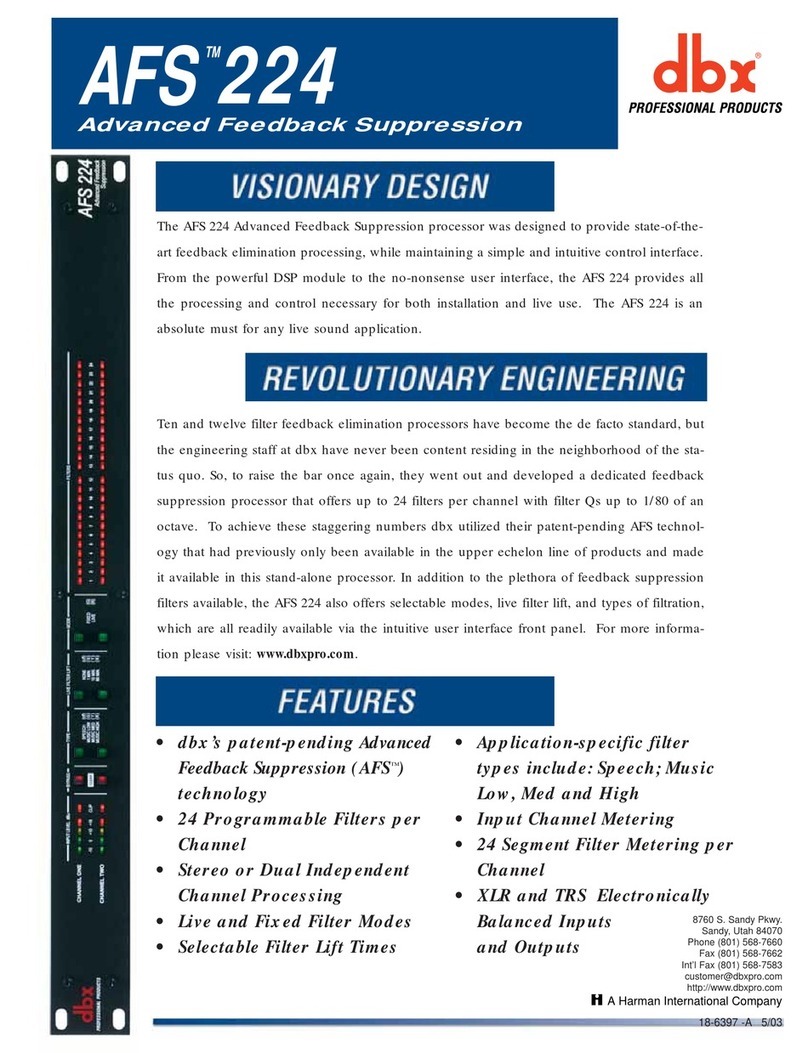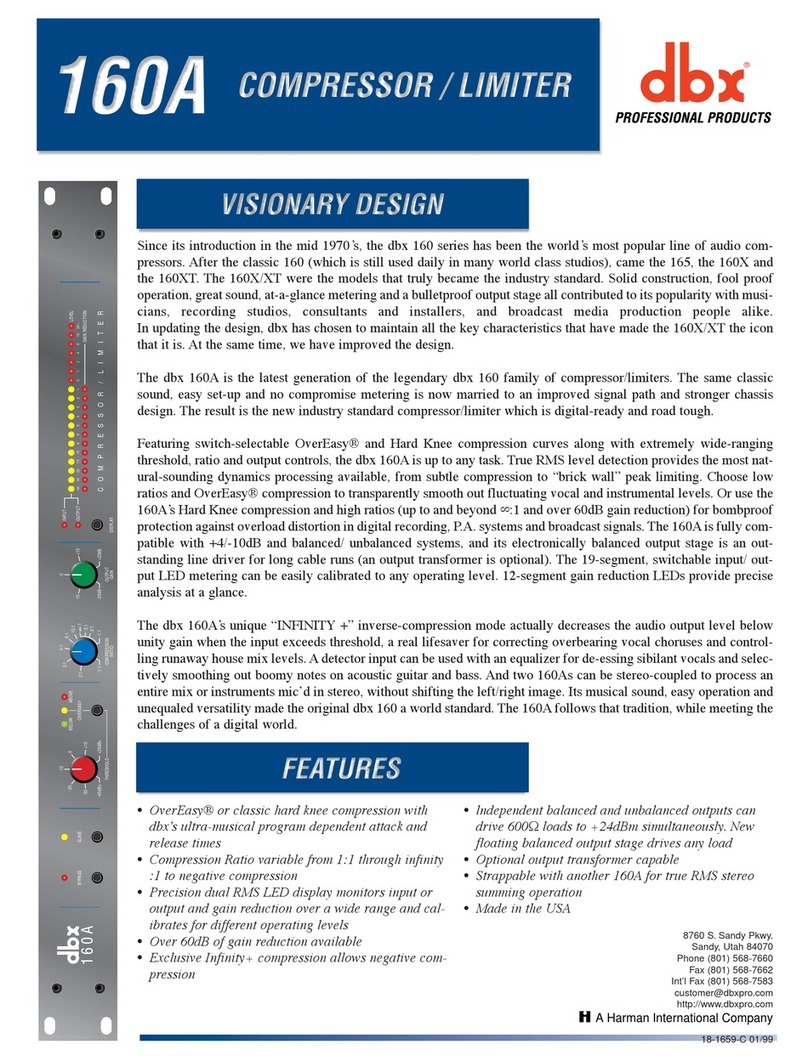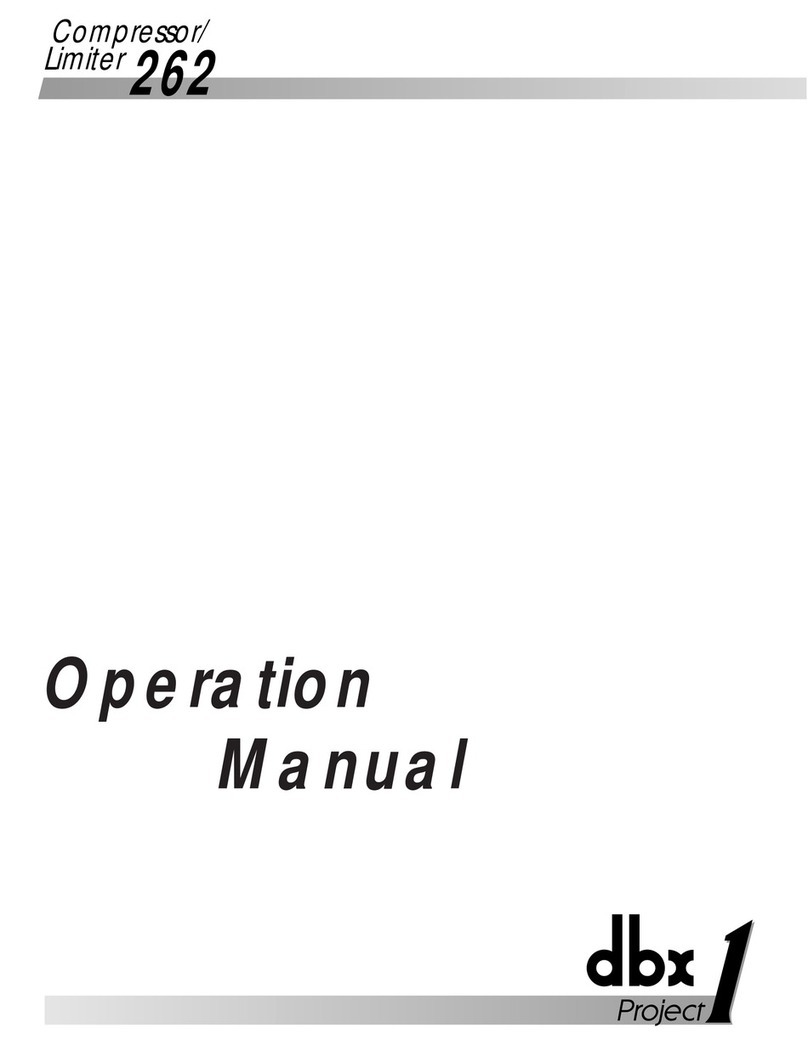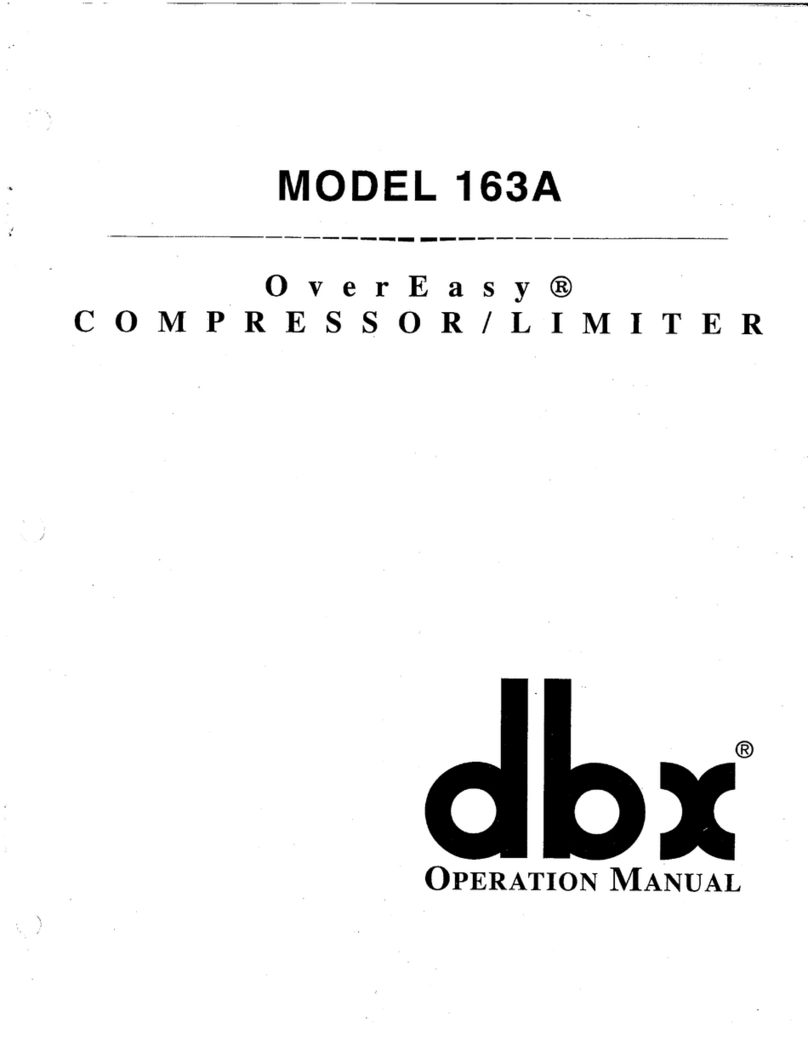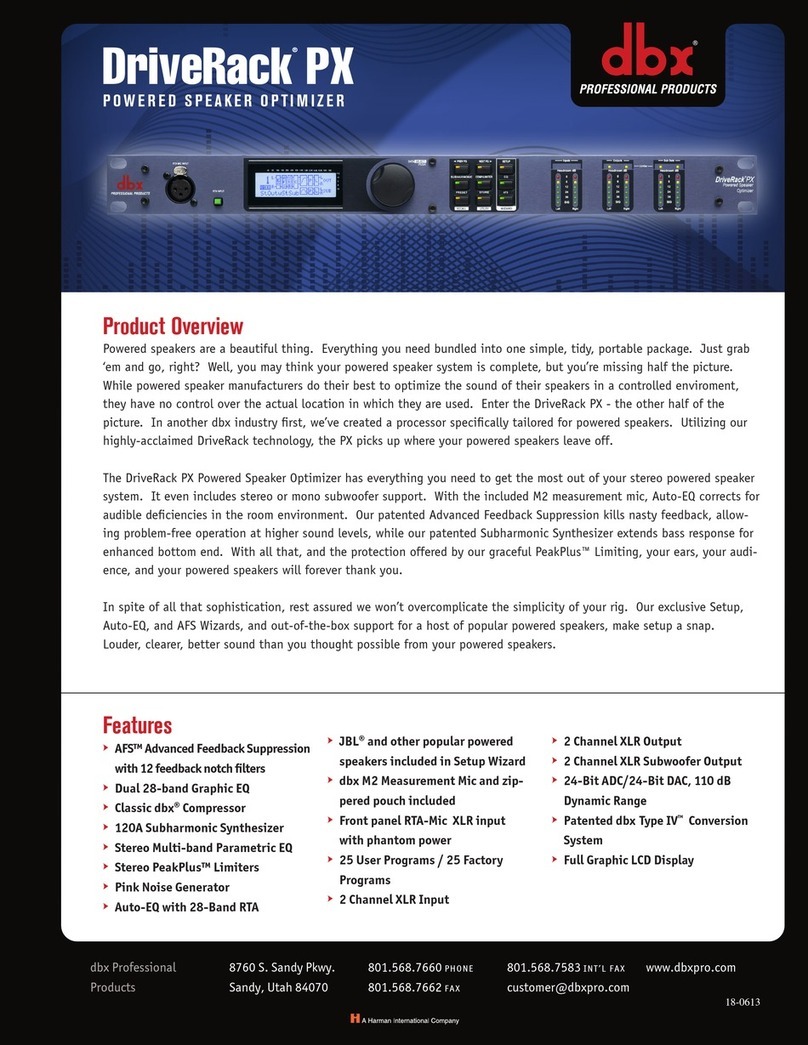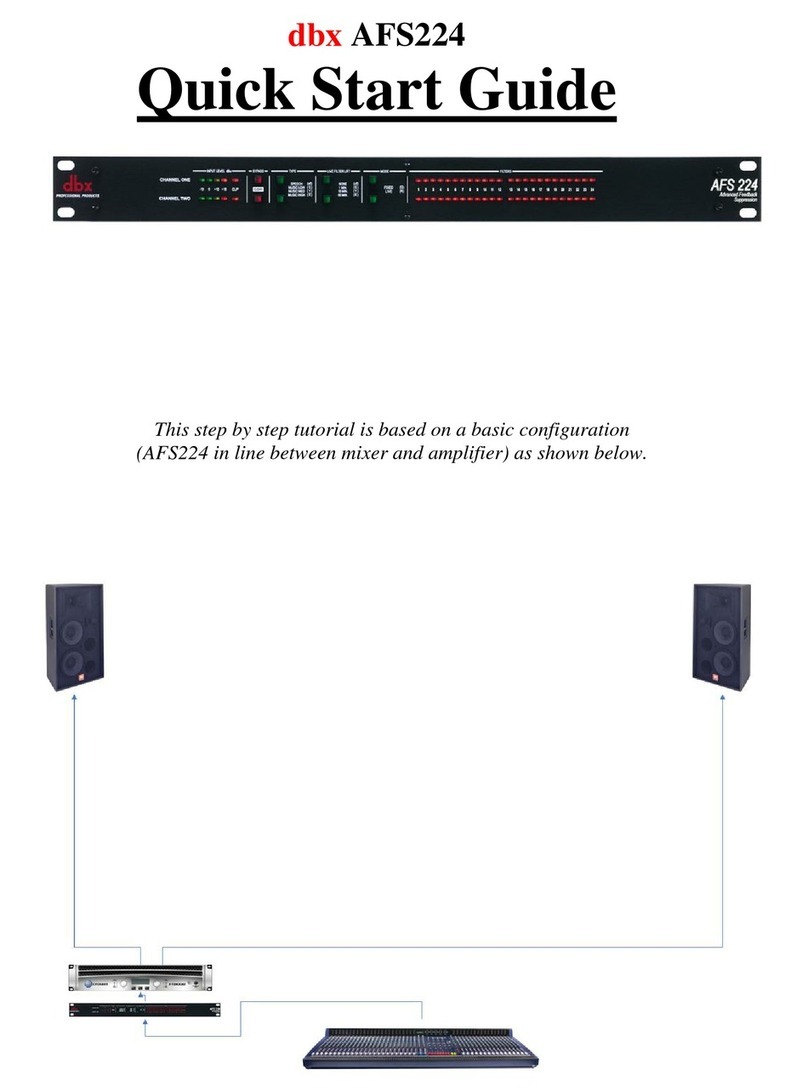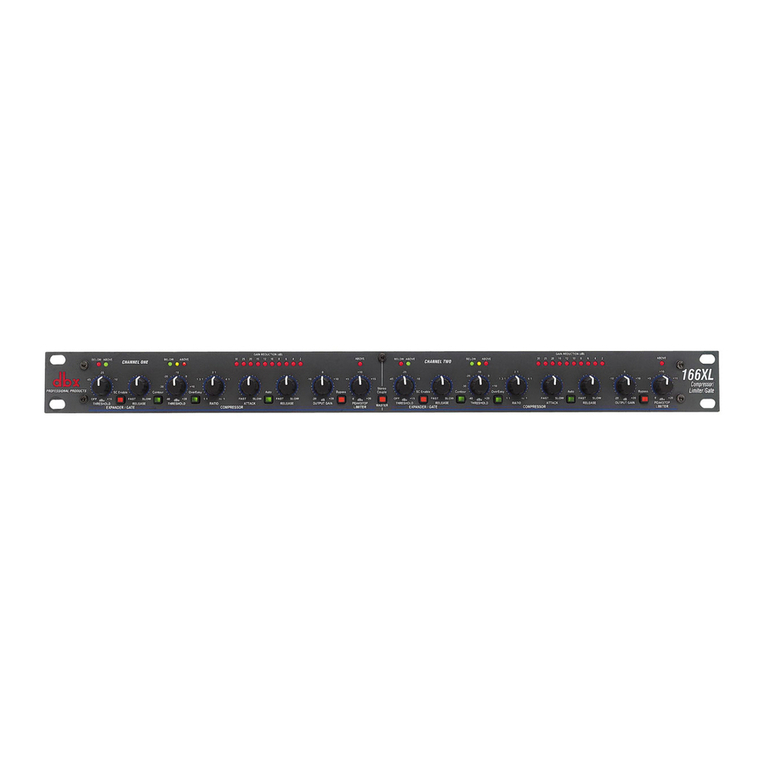dbx 160XT User manual

INSTRUCTION
MANUAL
0-
0
><
-t
n
0
3
.,,
""I
~
Cl'
Cl'
0
""I
'
r-
-·
3
®
Table of Contents
page contents
1 Introduc tion
3 Front Pane l
6 Rear Pane l
8 Connecting The l60XTToYour System
8 System Connections
12 Multi-Channel Connections
13 Special Connec tions (OPTIONAL)
13 UsingExternal Level Detector Inputs
14 Basic Operation (Control Descriptions)
18 Specific Applications
23 Installation Considera tions
23 Power Considerations
23 Mounting the 160XTin a Rack (OPTIONAL)
24 Input Cable Configurations
26 Output Cable Considerations
28 Transformer Balanced (OPTIONAL)
'29 Grounding
30 Maintenance and Techn ical Support
30 Maintenance and Troubleshoo ting
30 Technical support
30 Factory Service
31 Shipping Instructions
32 Specifications
34 Schematic (l60XTMain Board)
35 Glossary
51 Registrat ion. Warranty
51 Registration Card
51 Warranty
51 User-Feedback

CAUTION
RISK OF ELECTR IC SHOCK
00 NOT OPtN
CAUTION: TO REDUCE THE RISK OF ELECTRICAL SHOCK, DO NOT REMOVE COVER (OR BACK).
NO USER SERVICEABLE PARTS INSIDE. REFER SERVICING TO QUALIFIED SERVICE PERSONNEL.
WARNING :TO REDUCE THE RISK OF FIRE OR ELECTRICAL SHOCK , DO NOT EXPOSE THIS APPLIANCE TO RAIN OR MOISTURE.
This symbol, wherever it appears ,
alerts you to the presence of uninsulated
dangerous voltage inside the enclosure - voltage
that may be sufficient to constitute a risk of shock.
This symbol, whereverit appears,
alerts you to important operating and
maintenance instructions in the accompanying
literature. Read the manual.
This dbx-branded product has been manufactured by AKG Acoustics, Inc. under one or more of the following U.S. patents:
3,377,792; 3,681 ,618 ; 3,714,462; 3,789,143 ; 4,097,767 ; 4,329,598; 4,403,199 ; 4,409,500; 4,425,551 ; 4,473,795. Other patents pending.
This manual is part number 95096-000-01
© Copyright 1990 by AKG Acoustics, Inc.
dbx Professiona l Products
a division of AKG Acoustics, Inc.
1525 Alvarado Street, San Leandro, CA 94577 USA
Telephone (1) 415/351-3500 Fax: (1) 415/351-0500 Telex: 17-1480
Introduction dbx 160XT
/ ""
0 cln • • :ifrj.,,.. •.., ...,._ ~1••:••n1nnn1r.1•-
. .• =,tE
-- -... ·••··4•······ •·,_,. ----·····-----
0 ----- ----
"'-··
_.., --·
"QI' -
Congratulations on purchasing the dbx Model
160XTCompressor /Limiter . We recommend you
take a moment and read through the manual as it
provides information that will assist you from sys-
tem installation to operation to special applica-
tions. For a basic understanding of the terms used
in this manual, there is a Glossary of important
terms located in the back of the manual.
Wehave added a few new features to the dbx
Model 160XTwhile maintaining the performance
and ease of operation of its predecessor, the dbx
160X.We have added:
0
0
XL-type Input and Output Connectors -be-
cause the 3-pin XLconnector has been recog-
nized as the most durable and widely used
connector for professional applications.
Balanced Output - can drive a 6000 load to
+24dBu and provides common-mode rejec-
tion of unwanted noise in the audio path
such as RF and 60Hz components.
True Power Summing - When two 160XTunits
are slaved together, the RMS energy of the sig-
nal presented to the slave unit is summed
with the RMSenergy of the signal presented
to the master unit to prevent phase cancella-
tion of the two signals from causing unmusi-
cal compressor action. Note: a 160Xunit can
also beused with the same results as long as
the 160XTis used as the master unit.
Input Ground-Lift Switch -for isolation be-
tween shield ground and signal ground. Use-
ful when trouble shooting hum (AC line
interference).

2
Introduction
Other features include:
OVER EASy®/Hard Knee Selection - allows
selection between our famous Over Easy com-
pression curve and the classic "Hard Knee"
curve popularized by the original dbx 160,
161and 162.
True RMS Level Detection -senses the power
in the program in a musical manner , much as
the ear does, giving results superior to peak
or average detection.
Hardwire System Bypass Switch -allows the
audio to pass even if the unit is unplugged,
and is also useful for comparing the pro-
cessed and unprocessed signal.
Front Panel Stereo Coupling Switch -couple s
two 160XTsor a 160XTand a 160X toge ther
for stereo operation at the push of a button.
19 Segment Display -for high resolution mon-
itoring of True RMS input and output levels .
12 Segment Display -indi cating GAIN
REDUCTION.
Meter Calibration -input / output meter cali-
bration, so the 160XTcan be used in a variety
of situa tions where the "O"reference is not
consistent.
¼" Input and Output Connectors - we kept
the 1/4"phone jacks from the 160X, with the
Front Panel
C
dbx • • THREllHOLO ,,18:1
e e e 3:1 10:1
--
160XT BYPASS Bl.AVE THRESHOLD 01/Bl EASY
A B
output capable of driving its own additional
600Q load (single-ended) in addition to any
load at the XLoutput.
Detector Input -useful for specia l applications
including frequency conscio us compression
in which an external equalizer is used.
DC-controlled Parameters -the signal does
not pass thru any of the parameter controls.
Instead a DC voltage controls all functions
which eliminates any possibility of potenti -
ometer noise as the controls age.
The dbx 160XTis capab le of handling a wide
range of applications. In the studio, the 160XTcan
_be used on everything from vocals to percussion.
In live sound reinfor cement , the 160XTcan allow
the engineer to get that "fat studio sound" out of
the drum kit or provide protection limiting for the
speakers .In radio or television broadcast, the
160XTwill produce stable voice levels, even with
non-professional subjects.
dbx 160XT
0 -.n'
-10-•10--,__•••••••••••••••••••LEVEL
..._J ·«>301011510 al 1543I101 2,11010•
OUTPUT • • • • • • •• • • • • - GAINAEDUCTlON
- -
OUTPUT OISPI.AY
G.V,I COMPRESSOR/LIMITER
Figure 1:Front Panel
A. BYPASS switch and indicator
Depressing the BYPASSbutton creates a "hard -
wire bypass " of the 160XT's circuitry by con-
necting the input directly to the output; If the
160XTis being provided with AC power , an
LED above the switch turn s ON in Bypass
mode.
B. SLAVE switch and indicator
Depressing the SLAVE button on one 160XTof
a stereo pair determines that the other160XT
will be the Master (the controlling unit ).The
LED above the SLAVEbutton turns ON when
the 160XTis in Slave mode, indicating that the
front panel functions (with the exception of BY-
PASSand DISPLAYselect switches) are deacti-
vated and under control of the Master 160XT.
When neither 160XTis in Slave mode , each will
operate normally as a single channel compres-
sor/limiter.
C. THRESHOLD control
Adjusting this knob sets the threshold of com-
pression from-40dBu (7.8mVrms) to +20dBu
(7.8Vrms).
3

4
Front Panel
E F G
0 N'UT
dbx • • -10 THRESHOLD 4:1 1:1
-ec,~0 ..:.•~ 3:1~~~ 1
40~•10 -· 2:1~.;:,1
-10 • +10 --,__ e e e e e e ee e ee e e eee e e e I.E\IEL
--------.r--=-«> SO 10 1G10 e e 6 4 3 I 1 0 1 2 4 I 10 10 +
160XT 40 Bm +20dlm 1:1 •1:1 OUT1'IIT • • • • • e eee e e e -GAIN REDUCTION
-+l!Ooll
BYPASS 61.AIIE ~- COMPRESslON
THRESHOID ~= EASY RATIO ~T OISPI..AY COMPRESSOR/LIMITER
D H
Figure 2: Front Panel
D. OVER EASY switch
Depressing this button selects the Over Easy©
compression characteristic. The amber
:n:1RESHOLD LED turns ON when the signal
1s1nthe Over Easy region. When this button is
out, the 160XT operates as a hard-knee com-
pressor /limiter.
In hard-knee compression mode, the threshold
is defined as that point above which the output
level no longer changes on a 1:1basis with
changes in the input level. In Over Easy mode,
the threshold of compression is defined as the
middle of the Over Easy threshold region, that
Front Panel
F. COMPRESSION RATIO control
Rotating this control clockw ise increases the
amount of compression from 1:1 (no compres-
sion) up to infinity:1 (no increase in output
level, regardless of input level increases above
threshold); further clockwise rotation increa ses
compressio n into the INFINI1Y + region, up to
a maximum of-1:1 (i.e., a ldB increasein input
level above threshold causes a 1dB decreasein
outp ut level). In the INANl1Y + region, the
160XT inverts the program dynamics for spe-
cial effects.
G. OUTPUT GAIN control
Adjusting this control varies the amount of
fixed gain (up to +20dB) in the 160XT's output
amplifie r stage. The OUTPUT GAIN·contro l
does not interact with the threshold of compres-
•
s1on.
H. DISPLAY switch and indicator
Depressing this button causes the upper LED
array to display the INPUT level to the 160XT.
With the button out, the OUTPUT level is dis-
played. A pair of LEDs immediately above the
DISPLAY swi tch indicates the selected display
status.
is, "half-way" into compress ion, as shown in
Figure (See Figure 13).
E. THRESHOLD indicators
These three LEDs indicate the relation ship of
the input signal level to the threshold of com-
pression. The green "BELOW" LED is ON
when the signal is below threshold and the red
"ABOVE" LED is ON when the signal is above
threshold. When the 160XT is switched to Over
Easr ~ode, the amber LEJ? is ON when the sig-
nal 1s 1nthe Over Easy region (See Figure 13).
dbx 160XT
I. LEVELand GAIN REDUCTION displays
The upper row of 19 LEDs displays either the
INPUT or OUTPUT level, as selected with the
DISPLAYswitch. This display is factory set so
that OdBis equivalent to +4dBu input or output
level (1.23Vrms), but may be reset with the rear
panel METER CALIBRATION trimmer. (See fol-
lowing pages.)
The lower row of 12 LEDs displays up to 40dB
of GAIN REDUCTION caused by the 160XT.
(Fixed gain changes due to the OUTPUT GAIN
con trol are not displayed by the GAIN REDUC-
TION LEDs but are reflected in the OUTPUT
level display.)
5

6
Rear Panel
A C
1 INPUT- BA1..ANCEO-OUTI>llf 1
• !O~~o©
......
-· _J
81.EE\E QN) fl'IC 1 CIC) - ...., I • - ... I • •
..,
D 8 G
DE'TB:TOR 81&tD
N'UT IITRN'PNil
..,..,.
--
• &
-
~~
TAB
DC~
WLTAIEI
Figure 3: Rear Panel
A. SIGNAL INPUT jacks
The Tip/Ring/Sleeve phone jack and XL-type
connector are wired in parallel; either Signal
Input will accept an audio signa l for processing
by the 160XT.The phone jack accepts a stan-
dard TRS l/4" phone plug for a balanced input
source, or a 2-circuit (Tip/Sleeve) 1/4" phone
plug for an unbalanced source . The XL-type
plug connector is wired pin 3 HOT(+), pin 2
COLD(-) and pin 1GROUND.
B. DETECTOR INPUT
This Tip/Ring/Sleeve phone jack accepts a
standard TRS ¼" phone plug, and is of the
Rear Panel
"norrnalling" type. That is, when a phone plug
is inserted, the detector input is no longer con-
nected in parallel with the audio input.
C. SIGNAL OUTPUT -XL-type connector
The 160XThas an active-balanced amplifier ca-
pable of driving a 600 ohm (or greater) load to
+24dBu. Pin 3 is the HOT(+) lead, pin 2 is the
COLD(-) lead and pin 1 is circuit ground. Do
not short either pin 2 or pin 3 to ground, unless
you have installed the opt ional transformer.
This will not damage the unit, but may increase
distortion. (See page 28 for transformer balanc-
ing options.)
dbx 160XT
D. SIGNAL OUTPUT -phone jack G. STEREO STRAPPING jack
The 160XThas a separate single-ended (unbal-
anced) output amplifier also capable of driving
a 600 ohm (or greater) load to +24dBu. In nor-
mal operation the Tip/Ring/Sleeve phone jack
is internally wired with the TIP HOT(+), and
the RING and SLEEVE connected to circuit
ground. In BYPASSmode, however, the RING
is connected to the COLD (-) leads of the input
jacks, to allow for 1:1connections.
E. GROUND (GND) Lift switch
This switch allows for troubleshooting hum
(line interference) caused by ground loops. In
the "GND" position, pin 1 of the input XL-type
connector is connected to the 160XT's circuit
ground. In the "LIFT" position it is discon-
nected. This is not a chassis-isolate switch. The
circuit ground is floating with the respect to the
chassis.
F. METER CALIBRATION control
This screw-drive r-adjus table trimmer may be
used to precisely calibrate the front panel 's
upper LED display so a OdBINPUT or OUT-
PUT indication is equivalent to any signal from
- lSdBu (138mVrrns) to +lOdBu (2.45Vrrns).
When a TRS (Tip/Ring/Sleeve) ¼" phone plug
patch cable is inserted between two 160Xs,ste-
reo strapping can be achieved by depressing
the SLAVEswitch on oneunitonly.This will
provide accurate processing for a stereo pro-
.
gramrmng.
H. AC line voltage requirement indicator
This recessed indicator displays the nominal
AC line voltage for which the 160XThas been
set at the factory.
I. AC power cable
Connect this cable to any SOHzor 60Hz AC
power source of the correct line voltage, as
shown by the AC LINE VOLTAGE requirement
indicator above. The Model 160XT consumes a
maximum of 12 watts AC power.
WARNING: Besure to verify both your actual
line voltage and the voltage for which your
Model 160XT was wired, as indicated on the
rear panel of your unit. Connection to an inap-
propriate power source may result in extensive
damage which is not covered by the warranty.
•
7
Other manuals for 160XT
1
Table of contents
Other dbx Music Equipment manuals
